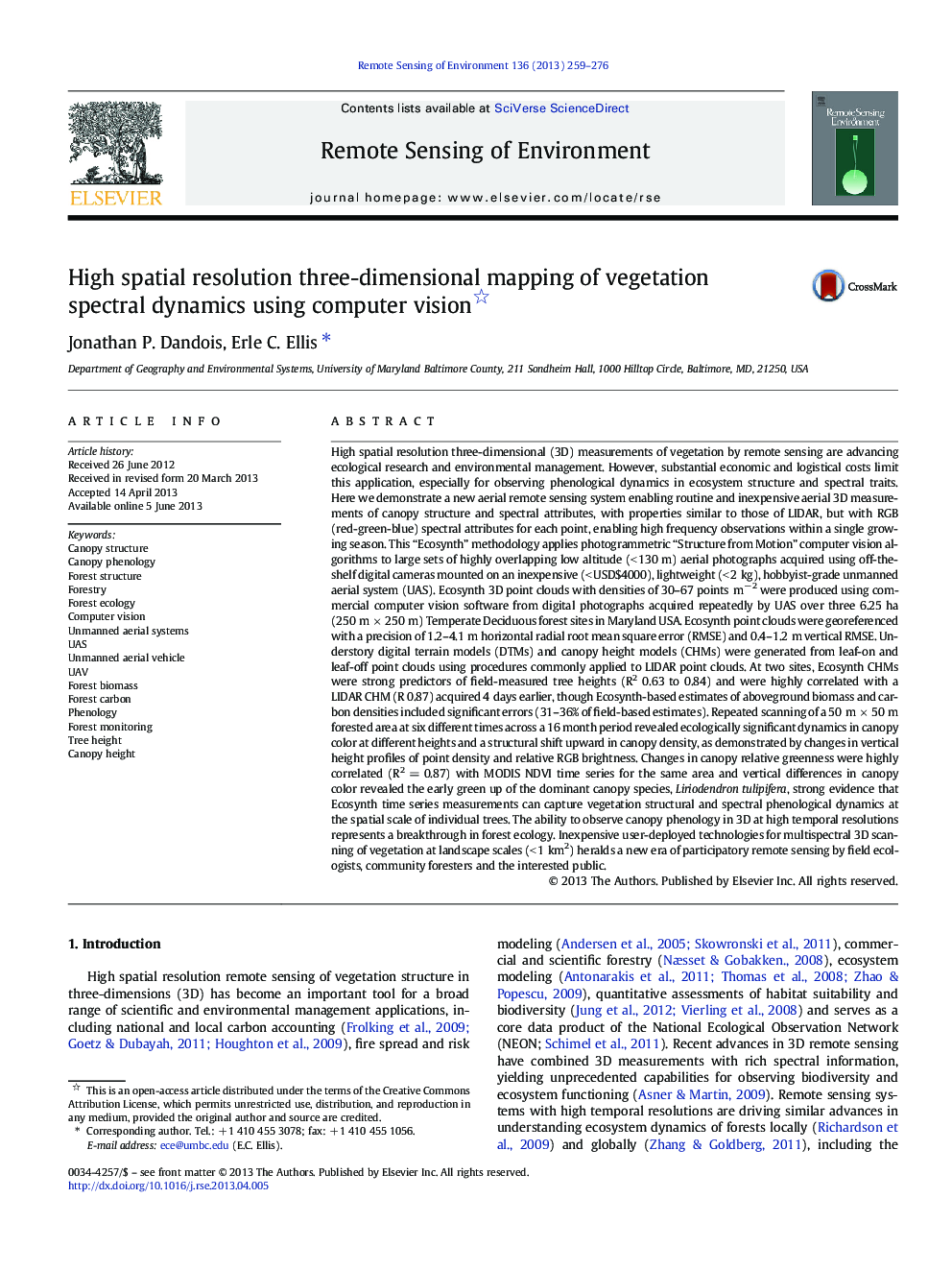| کد مقاله | کد نشریه | سال انتشار | مقاله انگلیسی | نسخه تمام متن |
|---|---|---|---|---|
| 6347415 | 1621264 | 2013 | 18 صفحه PDF | دانلود رایگان |
عنوان انگلیسی مقاله ISI
High spatial resolution three-dimensional mapping of vegetation spectral dynamics using computer vision
ترجمه فارسی عنوان
نقشه برداری سه بعدی با وضوح بالا از دینامیک طیف گیاهی با استفاده از دید کامپیوتری
دانلود مقاله + سفارش ترجمه
دانلود مقاله ISI انگلیسی
رایگان برای ایرانیان
کلمات کلیدی
UASTree height - ارتفاع درختCanopy height - ارتفاع سایبانComputer vision - بینایی کامپیوتر یا بینایی ماشینForestry - جنگلداریForest biomass - زیست توده جنگلForest ecology - زیست محیطی جنگلForest structure - ساختار جنگلCanopy structure - ساختار سایبانUnmanned aerial systems - سیستم های هوایی بدون سرنشینPhenology - فنولوژیForest monitoring - نظارت بر جنگلUnmanned Aerial Vehicle - وسیلهی نقلیهی هوایی بدون سرنشینUAV - پهپادForest carbon - کربن جنگلی
موضوعات مرتبط
مهندسی و علوم پایه
علوم زمین و سیارات
کامپیوتر در علوم زمین
چکیده انگلیسی
High spatial resolution three-dimensional (3D) measurements of vegetation by remote sensing are advancing ecological research and environmental management. However, substantial economic and logistical costs limit this application, especially for observing phenological dynamics in ecosystem structure and spectral traits. Here we demonstrate a new aerial remote sensing system enabling routine and inexpensive aerial 3D measurements of canopy structure and spectral attributes, with properties similar to those of LIDAR, but with RGB (red-green-blue) spectral attributes for each point, enabling high frequency observations within a single growing season. This “Ecosynth” methodology applies photogrammetric “Structure from Motion” computer vision algorithms to large sets of highly overlapping low altitude (< 130 m) aerial photographs acquired using off-the-shelf digital cameras mounted on an inexpensive (< USD$4000), lightweight (< 2 kg), hobbyist-grade unmanned aerial system (UAS). Ecosynth 3D point clouds with densities of 30-67 points mâ 2 were produced using commercial computer vision software from digital photographs acquired repeatedly by UAS over three 6.25 ha (250 m Ã 250 m) Temperate Deciduous forest sites in Maryland USA. Ecosynth point clouds were georeferenced with a precision of 1.2-4.1 m horizontal radial root mean square error (RMSE) and 0.4-1.2 m vertical RMSE. Understory digital terrain models (DTMs) and canopy height models (CHMs) were generated from leaf-on and leaf-off point clouds using procedures commonly applied to LIDAR point clouds. At two sites, Ecosynth CHMs were strong predictors of field-measured tree heights (R2 0.63 to 0.84) and were highly correlated with a LIDAR CHM (R 0.87) acquired 4 days earlier, though Ecosynth-based estimates of aboveground biomass and carbon densities included significant errors (31-36% of field-based estimates). Repeated scanning of a 50 m Ã 50 m forested area at six different times across a 16 month period revealed ecologically significant dynamics in canopy color at different heights and a structural shift upward in canopy density, as demonstrated by changes in vertical height profiles of point density and relative RGB brightness. Changes in canopy relative greenness were highly correlated (R2 = 0.87) with MODIS NDVI time series for the same area and vertical differences in canopy color revealed the early green up of the dominant canopy species, Liriodendron tulipifera, strong evidence that Ecosynth time series measurements can capture vegetation structural and spectral phenological dynamics at the spatial scale of individual trees. The ability to observe canopy phenology in 3D at high temporal resolutions represents a breakthrough in forest ecology. Inexpensive user-deployed technologies for multispectral 3D scanning of vegetation at landscape scales (< 1 km2) heralds a new era of participatory remote sensing by field ecologists, community foresters and the interested public.
ناشر
Database: Elsevier - ScienceDirect (ساینس دایرکت)
Journal: Remote Sensing of Environment - Volume 136, September 2013, Pages 259-276
Journal: Remote Sensing of Environment - Volume 136, September 2013, Pages 259-276
نویسندگان
Jonathan P. Dandois, Erle C. Ellis,
